12 Cribbage Strategies and Tips to Win
By Neal Taparia - 04/09/2025
Cribbage is a two-player card game with the goal of being the first person to score 121 points. However, you’re only dealt six cards per round, two of which you discard into a bonus hand for the dealer, referred to as the crib. Because you have just four cards and never draw new ones during play, you need an effective Cribbage strategy to score points to win.
Cribbage scoring is based on card combinations—you score points for the combinations in your hand as well as the ones you play during the pegging portion of the game. Additionally, the dealer receives bonus points for the crib hand, but players alternate deals so that both players receive this bonus. So with so many ways to score points but so few cards in play, strategy tips can help you make the most of your cards to score the highest points possible.
If you want to play Cribbage and have the best chance of winning, this post offers you a Cribbage strategy that works for every part of the game and tips suitable for both beginners and advanced players.
How Strategy Supports Cribbage Gameplay
If you’re not familiar with elements of the game, such as the go rule or how the crib works, you can visit our guide on how to play Cribbage to get a more detailed understanding. But don’t worry, Cribbage is an easy card game with just three stages or phases of play.
The first two phases require strategies, which we detail in this post, and what you do in the first phase can set you up for success in the last phase. The phases of a game of Cribbage are played in this order:
- Building the crib: After the dealer deals six cards to each player, players select two cards to place facedown into the crib. Strategy is vital in this phase because what you discard impacts the next two phases.
- Playing the hand (pegging play): Starting with the non-dealer (the pone), players take turns playing cards into the middle and calling out the total until they either reach 31 or get as close to it as possible without going over. In this phase, strategy will change as you must use the four cards in your hand to capitalize on cards played by your opponent and maximize points you peg (score) on the Cribbage board during this stage of play.
- Scoring the hands and the crib (the reveal): Once all cards from both players have been played, the non-dealer scores their hand. Then the dealer scores their hand and then the crib. Both players get to use the starter card to aid in making combos, which is like having five cards in your hand. Because of strategies you used in the first phase, you should already know what your hand totals, and the starter card may be able to help you score more. Revealing the crib will prove if your discard strategies were effective.
Just make sure you’re familiar with Cribbage scoring before diving into the strategies because understanding the points awarded for card combinations is integral to knowing which strategies you should use.
Cribbage Discard Strategy: How to Build the Crib
Because building the crib means shedding a third of your hand, you sometimes have to make difficult decisions at this stage. However, sticking to strategies helps you decide the best cards to place into the crib so that you build a strong hand to play and score.
Beginner Discard Strategies
As a beginner, you have a lot to keep track of, but don’t lose track of whose crib you’re discarding into. With these strategies, you can strengthen your hand as well as the crib—when it’s yours—and make tactical decisions when you’re giving cards to your opponent’s crib.
1. Discard the Least Valuable Cards to Make Your Hand the Strongest
Whether you have good cards is relative. With six cards, you can make so many card combinations that it’s difficult to decide what to keep, especially if you’re discarding into your opponent’s crib. So check out your hand for the strongest combination of four cards and discard the other two, even if that means giving points to the dealer.
If you’re dealt two fours, a six, seven, eight, and nine, you won’t do yourself any scoring favors by holding onto the pair of fours (worth 2 points) and discarding two others from the remaining cards. With two fours, you’d only score 2 points, but with the six, seven, eight, and nine, you have two sets of 15 (six plus nine and seven plus eight) worth 4 points total and a run of four (six, seven, eight, and nine) worth another 4 points—all without even knowing the starter card. Keeping the two fours ruins your chances of scoring 8 or more, depending on the starter card.
Keep this strategy in mind as you consider other discard strategies. This helps you prioritize which cards to keep and which to discard. Sometimes you will have to discard something valuable because you have so many scoring combinations. If that happens, count up the possibilities and discard what works best for your Cribbage hand to give you the most points.
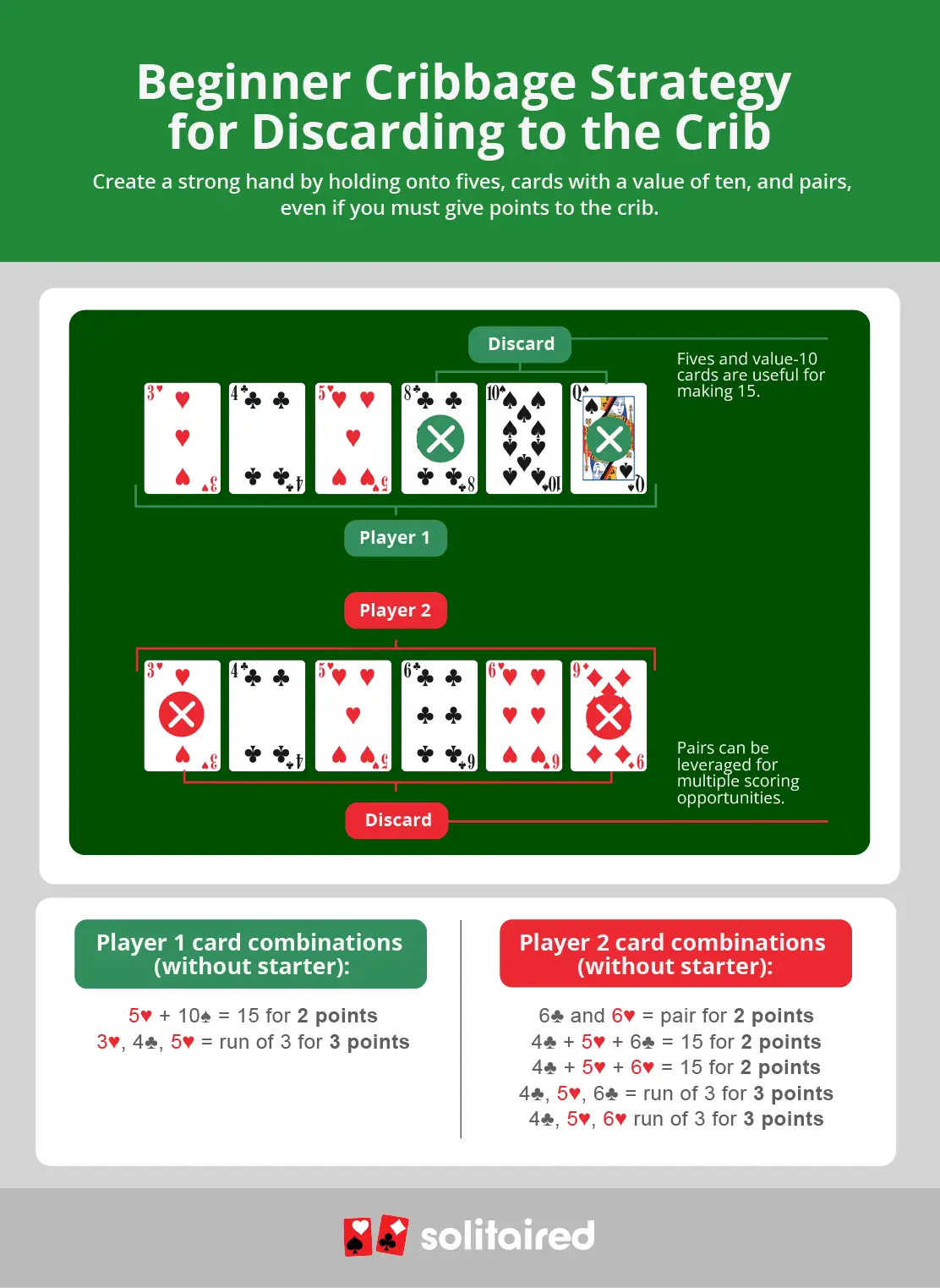
2. Keep Fives and Value-10 Cards
Several cards have a value of 10 and are referred to as “value-10 cards.” All face cards as well as tens are value-10 cards. Because 16 cards out of a standard 52-card deck have a value of 10, these cards are the most common cards in the game.
So discarding fives into the crib gives your opponent a strong chance of using it to make 15 if they discard a value-10 card into the crib or if it’s the starter card. However, keeping it in your hand gives you the opportunity to make 15 instead, either when pegging play or if the starter card is a value-10 card.
Because more cards in the deck have a value of 10, the likelihood of scoring with a value-10 card is higher than lower ranking cards. A card with a value of 10 can be paired with a five or combination of cards (like two and three) that equal five to make 15. So if a five is led or is the starter card, your value-10 card offers you some points. You can also use it to make 31 during pegging play once the total reaches 21 or try to snag the go point for playing the last card when the total is 18, 19, or 20.
3. Understand the Power of Pairs
Pairs may only be worth 2 points, but you can leverage them into even more. So watch how your pairs fit into other card combinations you can create. For example, a pair of fives with two value-10 cards, such as a queen and a king, make 15 four times (each five pairs with the each value-10 card) for a total of 10 points, including the pair.
Of course, a pair of fives can be valuable simply from their ability to create combinations that total 15, but other pairs can be just as powerful. For example, if you have a pair of fours with a two and a three, you can make two different runs of three for a total of 8 points (3 points for each run and 2 points for the pair).
Because pairs can lead to even more points, avoid putting them into the crib because you’re handing leverage worth 2 points or more to your opponent. If the crib is yours or your hand is so loaded you can afford to give those 2-plus points away, you can discard the pair.
Advanced Discard Strategies
If you’ve got the basic strategies down, you’ll need some higher level ideas for a more finessed approach to discarding into the crib, and these strategies will give you the edge you need.
4. Discard Consecutive Ranks to Your Crib
Keep cards like six and seven or eight and nine in your own crib as you have a lot of opportunities to get a “touching card” (a card that finishes or begins the sequence). For example, if you discard a seven and eight to your crib, you can score 3 points if the starter card or one of your opponent’s discards is a six or a nine.
For the same reason consecutive ranks are valuable to your crib, you should avoid putting them in your opponent’s crib. However, you don’t need to keep these in your hand just to keep them from the opponent if they don’t boost your hand, helping to make 15, pairs, or other card combinations. But if you don’t have any other useful cards for pegging play, keep them in your hand. You may have a chance to play a sequence during pegging or score with the starter card.
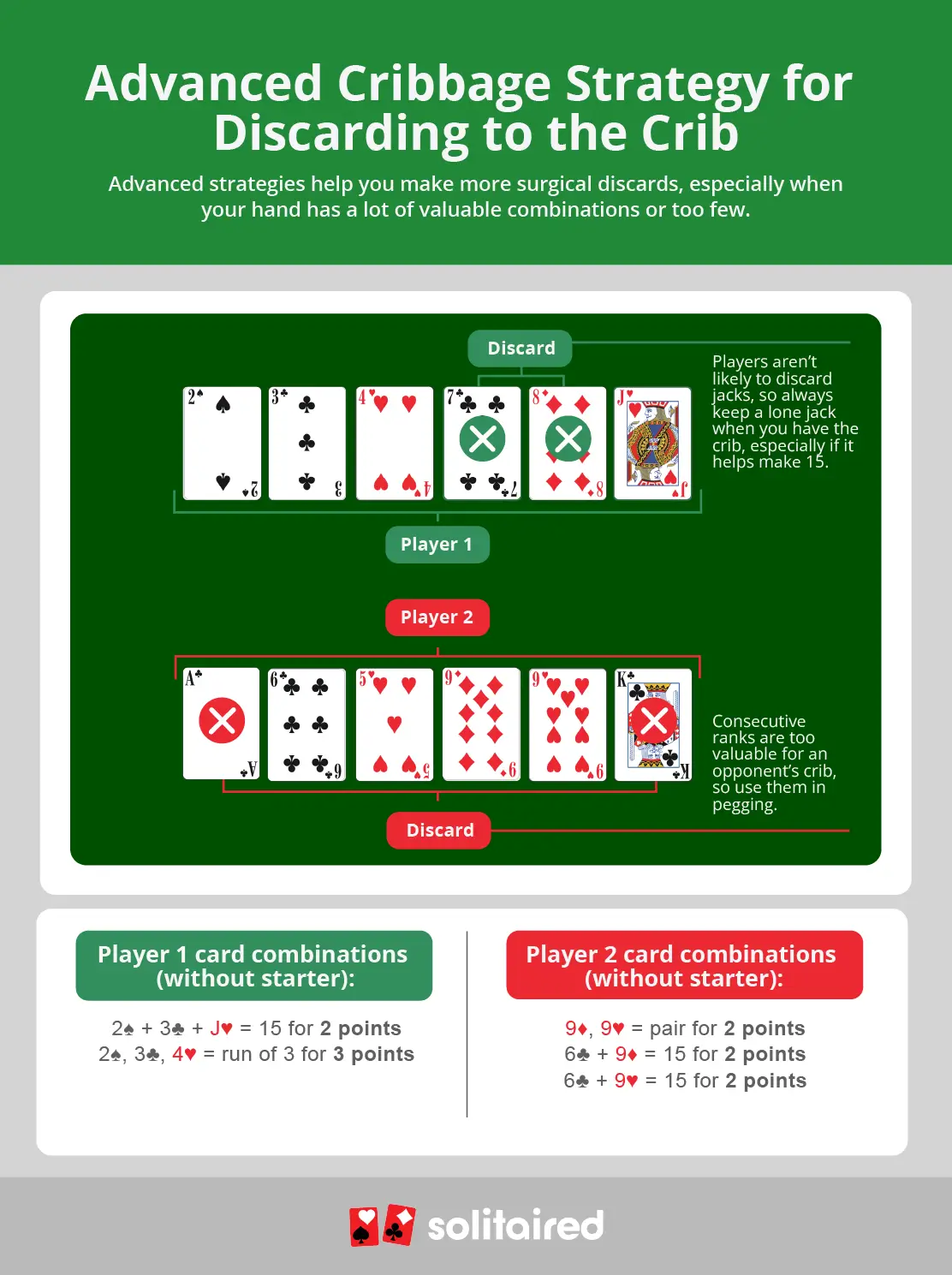
5. Hold a Jack
You should keep a single jack because it has more value than other value-10 cards. A single jack could end up being nobs, worth one point, if the starter is the same suit. Plus, jacks are better at making runs than other value-10 cards. A king and queen must have a jack to create a run, but a jack can go with a king and queen or a nine and ten to create a run.
Opponents are less likely to discard a value-10 card to your crib because they are so useful, and because a jack has more value, they’re even less likely to discard a single jack. So you have little chance of increasing your crib score by discarding a single jack unless you have a five to pair with it. You’re better off holding it in your hand and using it for pegging.
6. Keep Magic 11s
Magic 11s are card combinations that add to 11. If you’re the dealer, you’d want pairs, such as a three and eight, five and six, and four and seven. If you’re the non-dealer, you’d need to keep a three-card combination that adds to 11.
Magic 11s are good to keep because you can use these cards to help get you to 31 and get the extra pegging point. Keep in mind that the effectiveness of playing a magic 11 depends on your opponents’ playing style. Most players would never lead a five, but they very well could lead a value-10 card. Because they are trying to protect their other value-10 cards from being used to make 15, they will likely follow up with your play with a value-10 card, too.
If a value-ten card is led, then play the first magic 11, for example, a four. If your opponent plays a value-10 card for 24, then you play the matching magic 11 card, a seven, for 31. If you’re the non-dealer, then you’re using three cards, leading a low card first, such as a four. Then if the dealer plays a value-10 (total is 14), you follow up with a three (for 17). If your opponent plays another value-10 (total is 27), and you can end the round with another four for 31.
Cribbage Pegging Strategy: How to Play for Points
According to the Theory of 26, created by Delynn Colvert, on average, the non-dealer scores 10 points, and the dealer scores 16 points total each round in pegging play and hand counts. So every two rounds, on average, each player scores 26 points.
This means that the dealer, typically, is set up to win unless the non-dealer is more strategic. Extra points can add up, so you need to employ some strategies not only when you build the crib but also when you play the hand to change the momentum of the game.
Beginner Pegging Strategies
Having some strategies in place can make you confident for what to lead and how to make plays that score points. So use these Cribbage tips to make the most of the cards you have to play.
7. Know When to Play Fives—or Not
While many strategies are dependent on what else is in your hand, one strategy you can consistently apply is to never lead a five. Your opponent likely is holding a value-10 card since they are the most common cards, so leading a five offers an easy opportunity for them to make 15.
However, because you don’t want to be forced to lead them in the next round, play them quickly after the lead to protect them. Of course, your opponent could be trying to lure your five out or trap it for a run. So avoid playing them when a four or six is played to avoid creating a run, but if it’s a three-four string, be sure you capitalize on it to score the 3 points.
8. Lead Low Cards
When you’re the non-dealer, you want to lead a low card when playing the first card. Higher cards, such as a six, seven, eight, nine, and the value-10 cards are just too easy for your opponent to play one card to make 15.
Fours may not be a high-value card, but they are the perfect lead because the highest card your opponent could play is one worth 10, bringing the total to 14. Then you could play an ace for 15 and score 2 points. Plus, fours aren’t as useful later as you get closer to 31.
However, if you don’t have a four, play a lower ranking card, like a three or two. You can still set yourself up to play a third card for 15 and score 2 points, but just remember that twos, like aces, could be useful later in the game.
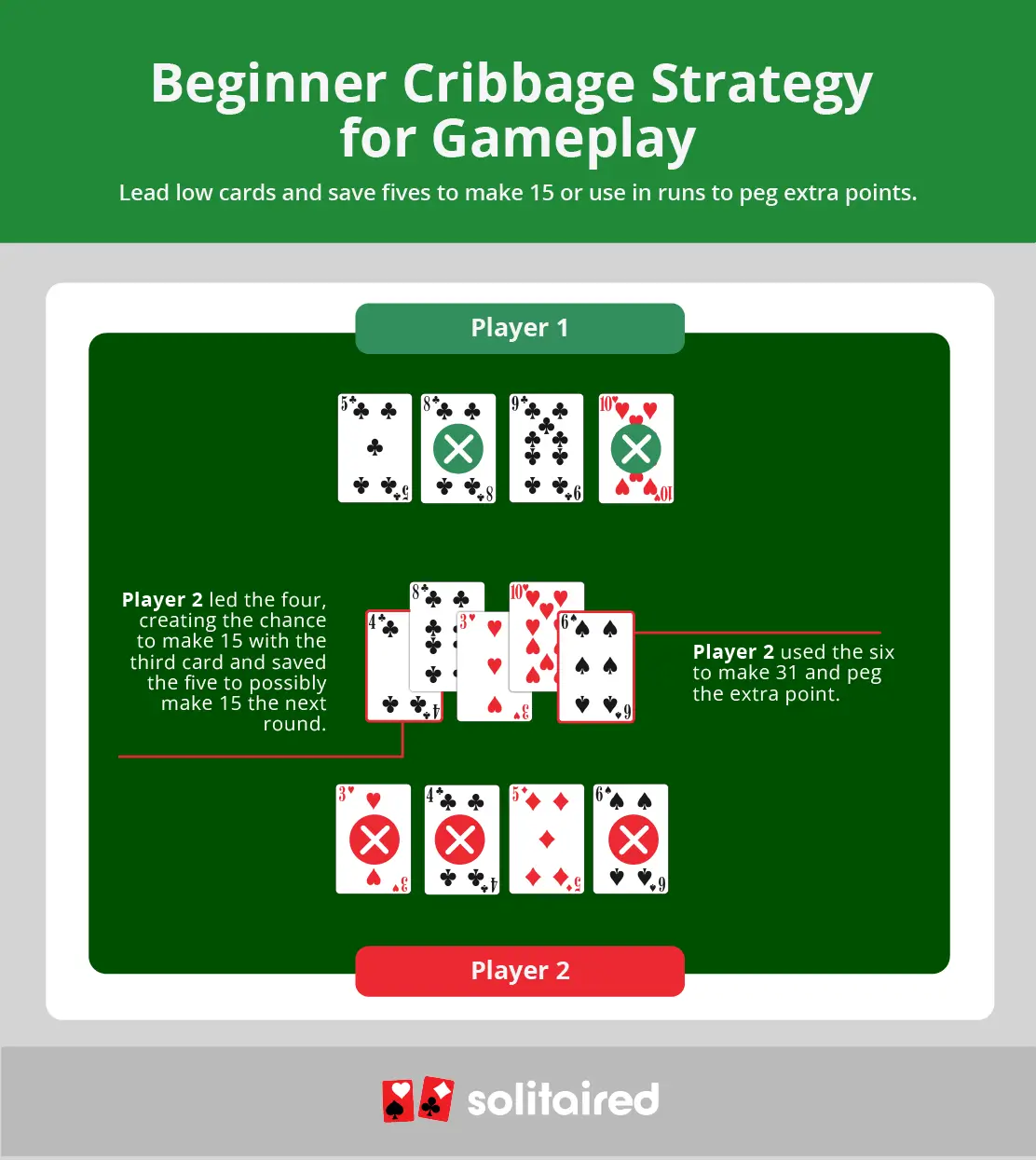
9. Watch the Score
As you near the end of the game, watch the board position as players get closer to around 116 points. Remember that the non-dealer always scores their hand first, so the crib won’t matter as much if someone could peg their way to 121 before the hands get counted.
So while you or your opponent gets closer to 121, remember these guidelines:
- Regardless of whether you’re the dealer, you want to maximize pegging points because that could win you the game before any hand is counted.
- If you’re not the dealer, remember that your hand is counted first, so your hand will score before the dealer. While you want to be aggressive during gameplay, even if you don’t peg to 121, what you keep in your hand is more important than ever.
- If you’re the dealer, you have to be the most aggressive during pegging at the end of the game. That may be your only path to victory since your opponent’s hand will be counted first.
Advanced Pegging Strategies
If you’ve got the beginner strategies down, stepping up your game with some advanced strategies can help you peg even more points.
10. Bait Your Opponent
As an advanced Cribbage player, you’re likely playing someone on your level. So you know they’ll be holding magic 11s and other strong combinations. So play offensively, rather than defensively by offering low-hanging fruit, in terms of points, so you can capitalize on cards played for more points
For example, if you have a pair of fours, play one of the cards from your pair. If they have a matching card, they’ll want the 2 points, which means you can follow up with your second four to score a triple, which is 6 points. It’s worth offering 2 points to your opponent to give yourself three times that amount!
Another example for baiting includes baiting the run. If you have a seven, eight, nine run in your hand, you won’t be able to play that consecutively during pegging. But if you lead your seven, you could bait your opponent into playing the eight for an easy 15, worth 2 points. Then you can play your nine for a run of three, worth 3 points. It may seem counterintuitive, but even if you offer some points to your opponent, you’re still scoring more points, helping you reach 121 faster.
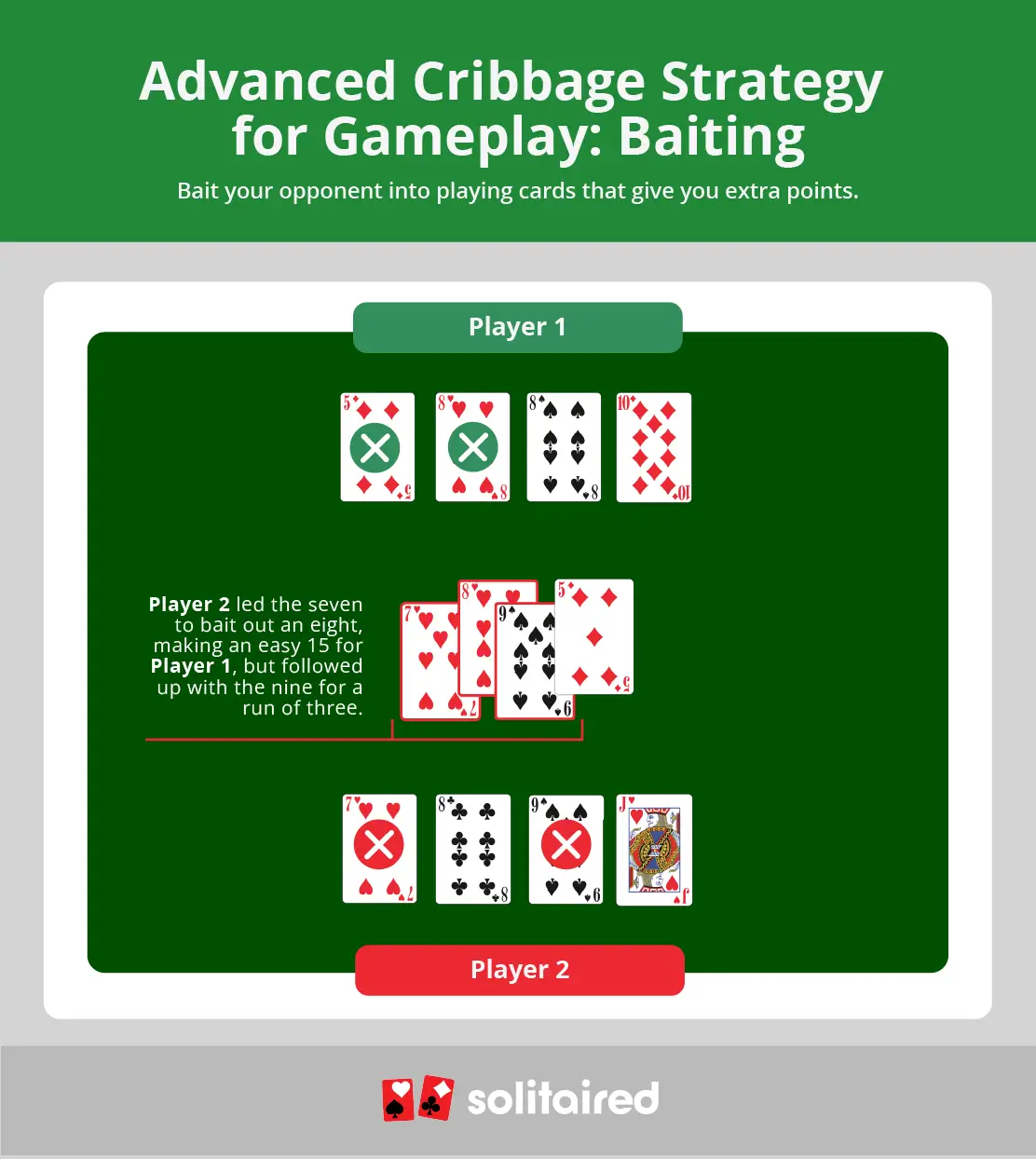
11. Trap Fives
Different from baiting your opponent, trapping fives is an effort to capitalize on near-sequences that require a five. Since your opponent wouldn’t lead a five, you need to force them to keep it and not play it in the first round to 31.
If you have cards that need a five to finish the sequence, such as three and four, six and seven, or four and six, keep those cards until the end of the first round, pushing the total with value-10 cards so it’s not helpful for the pone to play a five.
Because experienced players will likely be playing magic 11s and trying to make 31 with 10-value cards, you can often trap a five after the first 31 is made. For example, you can trap the five by laying down a seven, making the five a good play that won’t make 15. Then you can lay the six down for a run of three and score 3 points.
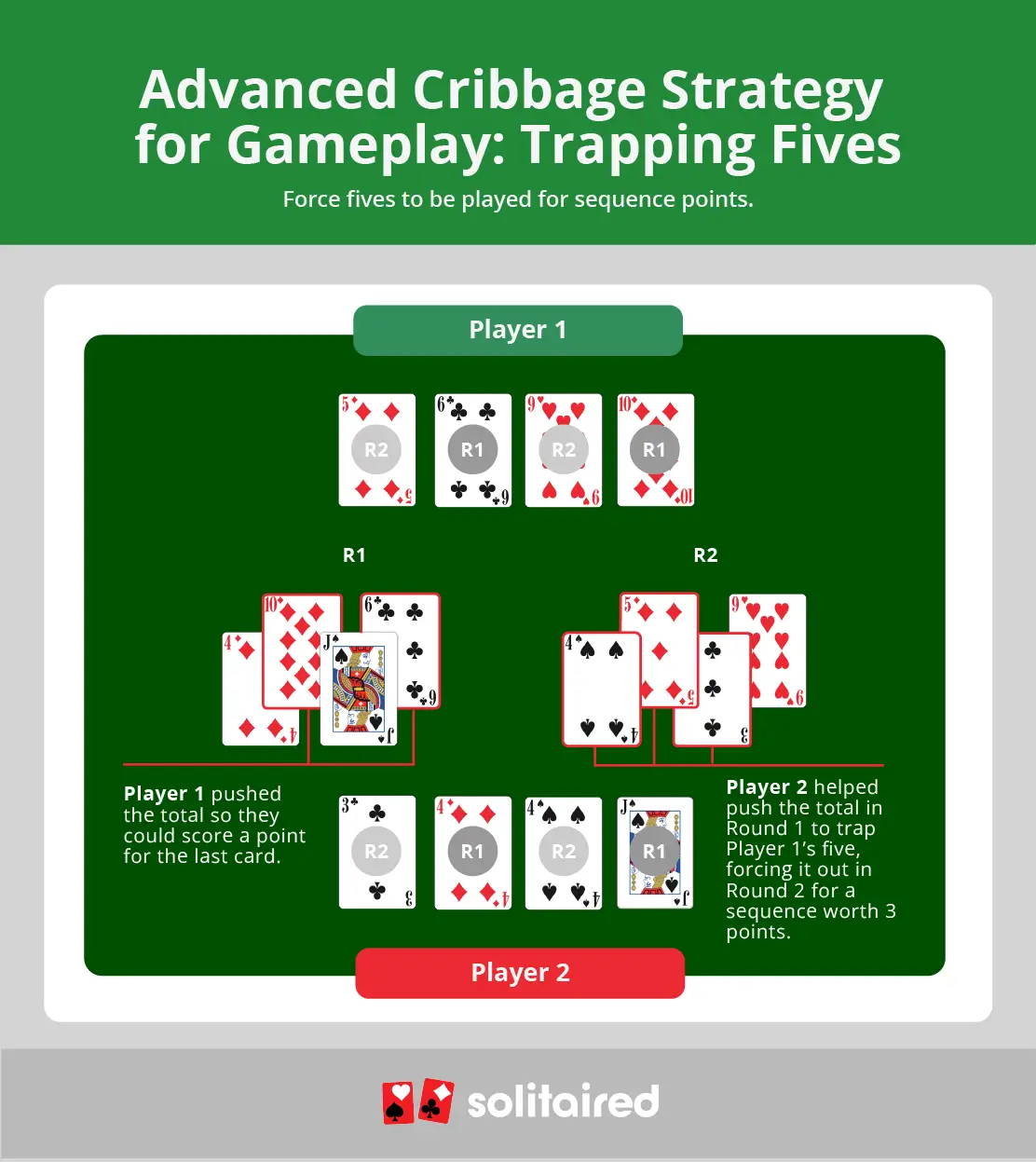
12. Watch Your Opponent’s Play
For many advanced strategies, their ability to produce points depends on understanding what your opponent is playing. If you’re playing another advanced player, you know they’re operating under similar strategies. So you can deduce what they have just by watching them play.
So watching their lead and subsequent cards played can help you foil their plans or adjust your game strategy so you don’t fall into any traps. While your plans are offensive in nature, you also need a good defensive strategy, too.
Like other types of card games, playing Cribbage is even more fun when you try out strategies and find ones that work best for you. Whether you’re a beginner or advanced player, you can play easy, standard or pro-level Cribbage on Solitaired.
About the author

